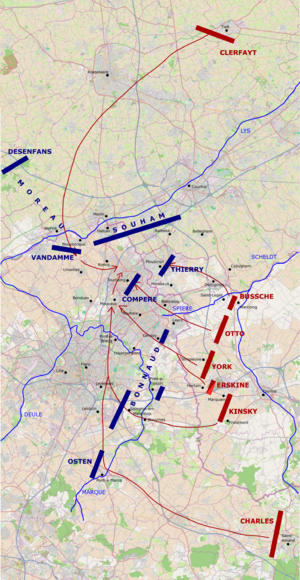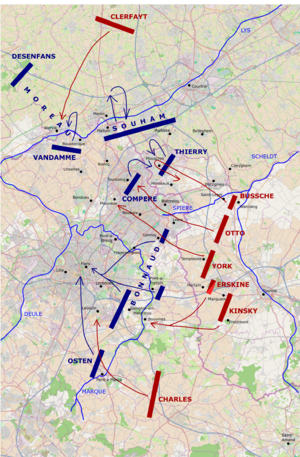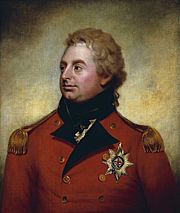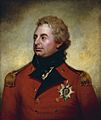Battle of Tourcoing facts for kids
Quick facts for kids Battle of Tourcoing |
|||||||
|---|---|---|---|---|---|---|---|
| Part of the Flanders campaign in the War of the First Coalition | |||||||
 Frederick, Duke of York, narrowly escapes capture after his column is isolated and crushed at the battle of Tourcoing |
|||||||
|
|||||||
| Belligerents | |||||||
| Commanders and leaders | |||||||
| Units involved | |||||||
| Army of the North | Coalition Army | ||||||
| Strength | |||||||
| 70,000-82,000 | 74,000 | ||||||
| Casualties and losses | |||||||
| 3,000 casualties 7 guns |
4,000 killed or wounded 1,500 captured 60 guns |
||||||
The Battle of Tourcoing was a major battle fought on May 17–18, 1794. It took place near the town of Tourcoing in northeastern France. This battle was part of the War of the First Coalition, where revolutionary France fought against a group of European countries.
In this battle, the French army, led by General Joseph Souham, faced an attack from a large group of armies called the Coalition. The Coalition included soldiers from Austria, Great Britain, Hanover, and Hesse. Even though the French commander, Jean-Charles Pichegru, was away, Souham and other generals like Jean Victor Marie Moreau and Jacques Philippe Bonnaud quickly planned a counterattack. They managed to defeat the Coalition forces, who were spread out and not working well together.
The Coalition's plan was to surround a part of the French army. They sent six different groups of soldiers, called columns, to attack. On May 17, some of the Coalition columns made slow progress, and one small column was even defeated. On May 18, the French focused their attack on the main Coalition columns. This led to a big defeat for the Coalition troops.
Contents
Background to the Battle
Armies and Their Plans
In 1794, Lazare Carnot, a leader in the French government, created a plan for the French armies. His idea was to attack both sides of the Coalition army. This Coalition army was defending the Austrian Netherlands, which is now Belgium and Luxembourg. The French aimed to capture important cities like Ypres, Ghent, and Brussels.
The French Army of the North, led by General Jean-Charles Pichegru, had many soldiers. They had about 126,000 soldiers ready for battle. The Coalition army was also very large, with different groups of soldiers spread out. The main Coalition force was led by Emperor Francis II of Austria and Prince Josias of Saxe-Coburg-Saalfeld.
Early Operations
Before the Battle of Tourcoing, there were other fights. In April, the Coalition captured a French fortress called Landrecies. This was a setback for the French. However, the French had also captured some of the Coalition's battle plans.
With these plans, the French launched attacks. One French division, led by Jean Victor Marie Moreau, laid siege to Menen. Another, led by Souham, captured Kortrijk. These actions broke through the Coalition's defenses.
The Coalition then moved their forces to stop the French. The Duke of York, a British commander, joined forces with Austrian General Clerfayt at Tournai. They planned for Clerfayt to attack Kortrijk from the north, while York attacked from Tournai.
On May 10, the French attacked the Coalition troops at Tournai in the Battle of Courtrai. The French were forced to retreat. The next day, the French pushed Clerfayt back. York realized the French had more soldiers and asked for more help.
The Coalition leaders debated where to send their main army. After a smaller victory on May 13, Emperor Francis II decided to move the main army west towards Flanders.
Around this time, a rebellion started in Poland. This surprised the European powers. Prussia, one of the Coalition members, decided to pull 20,000 soldiers out of the war against France to deal with the situation in Poland. This weakened the Coalition forces fighting in France.
The Battle Plan
On May 16, the Coalition army made a new battle plan. It was called the Vernichtungsplan, which means "Annihilation Plan." The goal was to cut off the French army from their supply lines and drive them out of Flanders.
The battlefield was mostly flat, with many villages and farms surrounded by hedges. This made it hard for cavalry to move freely, which was an advantage for the French.

The Coalition divided their army of about 73,000 soldiers into six columns. Each column had a specific path to follow.
- The first column, led by Bussche, was to move north and then west to Mouscron.
- The second column, led by Otto, was to go northwest through Leers and Tourcoing.
- The third column, led by the Duke of York, was to advance alongside Otto's column through Lannoy and Mouvaux.
- The fourth column, led by Kinsky, was to cross the Marque River at Bouvines.
- The fifth column, led by Archduke Charles, was to march from Saint-Amand-les-Eaux and eventually join York's column.
- The sixth column, under Clerfayt, was to move south from Tielt, cross the Lys River, and push towards Tourcoing.
Meanwhile, the French army, temporarily led by Souham, had about 82,000 soldiers. Their divisions were positioned between Courtrai and Lille.
The Battle Unfolds
May 17: Coalition Delays
The Coalition's plan immediately ran into trouble. Clerfayt's column received its orders late and started marching slowly. They didn't reach the Lys River until the afternoon of May 17. The bridge they needed to cross was strongly defended by the French. Clerfayt's pontoon bridge equipment was also missing, causing more delays. His troops couldn't cross the river until very late that night.
The other columns also faced difficulties. A heavy fog covered the area. Kinsky's column, which was supposed to join Charles, delayed its march because Charles was behind schedule. Charles's column had a long march and didn't reach its position until late afternoon on May 17. His soldiers were too tired to continue. These delays meant the Coalition columns were not in their planned positions.
Meanwhile, Bussche's column captured Mouscron but was then pushed back by French counterattacks. Otto's column managed to push the French out of Tourcoing. York's column also advanced, capturing Lannoy and Roubaix. However, York decided to stop his advance at Roubaix because Mouscron was still held by the French, and he hadn't heard from Otto or Kinsky. Emperor Francis II, however, ordered York to continue to Mouvaux. York's troops then captured Mouvaux, driving the French out and capturing cannons.
May 17: French Counter-Plan

On the morning of May 17, the French generals didn't fully understand the Coalition's plan. They only knew about Clerfayt's column. But as more reports came in, they realized they were in danger of being surrounded.
That evening, the French generals, including Souham and Moreau, met to plan their response. They decided on a bold counterattack. Moreau would defend against Clerfayt, while Souham and Bonnaud would launch a surprise attack. They planned to use about 40,000 troops against the 20,000 Coalition soldiers under York and Otto, who were now exposed.
The Coalition headquarters knew that some of their columns were behind schedule. York asked for permission to pull back, but his request was denied. Orders were sent to Charles to march immediately, but they were not delivered quickly.
May 18: The French Strike Back

At 3:00 am on May 18, the French army began moving into position for their attack. They left some troops to watch Kinsky and Charles, who were still far away. Bonnaud split his 18,000 troops into two groups, attacking Roubaix and Lannoy. Other French brigades attacked Mouvaux and Tourcoing.
The French attack hit Otto's column at dawn. Otto's troops were quickly overwhelmed. The Austrian commander at Tourcoing tried to defend, but his forces were broken up and forced to retreat. The Hessian soldiers in Wattrelos were also outnumbered and had to retreat.
Bonnaud's division also attacked York's troops at Roubaix and Lannoy. French forces from Tourcoing also appeared, attacking York from the north. York's British Guards brigade found itself isolated. York ordered them to fall back to Roubaix.
The Guards brigade tried to retreat, protecting their cannons. But they were ambushed by French soldiers. The artillery drivers panicked, abandoning their guns and blocking the road. The British cavalry crashed into this blockade, and the French fired on them. Many soldiers and even civilians following the army were killed in the chaos. York's column lost many cannons.
York himself barely escaped capture. He rode through Wattrelos, where he was fired upon, and then crossed a brook to safety. He almost became a prisoner of the French.
May 18: Clerfayt, Kinsky, and Charles
At 7:00 am, Clerfayt's column finally crossed the Lys River. They marched towards Linselles and Bousbecque, where they met the French brigade led by Dominique Vandamme. Clerfayt pushed back Vandamme's troops and captured some cannons. However, Vandamme's men regrouped and pushed Clerfayt back. Clerfayt thought the French had received many reinforcements and decided to pull back.
Kinsky's column remained inactive, even when urged to advance. Kinsky claimed he was sick and no longer in command. He eventually withdrew after hearing about the defeat of York and Otto. Charles's column also moved very slowly. Even though he received orders to march to Lannoy, his troops didn't move until noon. By the time they reached the main road, new orders told them to fall back. The lack of action from Kinsky and Charles meant that the main Coalition forces did not help York and Otto, leaving them to face the French alone.
Results of the Battle
The Battle of Tourcoing was a clear French victory. The French lost about 3,000 soldiers and 7 cannons. The Coalition suffered much heavier losses, with about 4,000 killed or wounded and 1,500 captured. They also lost around 60 cannons.
The French did not chase the defeated Coalition army. Emperor Francis II and his Austrian generals were very discouraged by the outcome. The British soldiers, however, remained determined, but they were upset with their Austrian allies for not helping them more.
After the battle, Mack, the Coalition's chief-of-staff, resigned. He believed that taking back the Austrian Netherlands was now a lost cause. The next day, a meeting was held, but only York wanted to continue the attack. General Pichegru returned to his army on May 19 and began planning for the next battle, which would be the Battle of Tournai.
Images for kids
-
Map showing the French and Allied positions on 16 May, the day before the battle, as well as the Allied plan of attack for the battle of Tourcoing. Coburg planned to use a heavy attack from his left flank to outflank and cut the French army off from their base at Lille, while Clerfayt would close the trap from the north and surround the French.
-
The first day of the Battle of Tourcoing, 17 May. The attacks of the right wing under York and Otto have gone according to plan, but Bussche on the extreme right has been pushed back from Mouscron. Charles and Kinsky, the crucial left hook, have been badly delayed by Charles' long march, and Kinsky's conforming to his pace. Clerfayt, already behind schedule, is halted for the rest of the day at the Lys waiting for bridging equipment. Souham crosses the Lys to counter Clerfayt, but recrosses it when York, Otto and Bussche attack.
-
The second day of the Battle of Tourcoing, 18 May. Souham and Bonnaud improvise a pincer counterattack on the columns of Otto and York, who have been left exposed in a salient by the failures of Clerfayt, Charles and Kinsky to advance, and by Bussche's repulse. Otto and York are crushed while Charles and Kinsky stand by, Clerfayt is repulsed by Vandamme, and what remains of the Allied forces withdraw.











